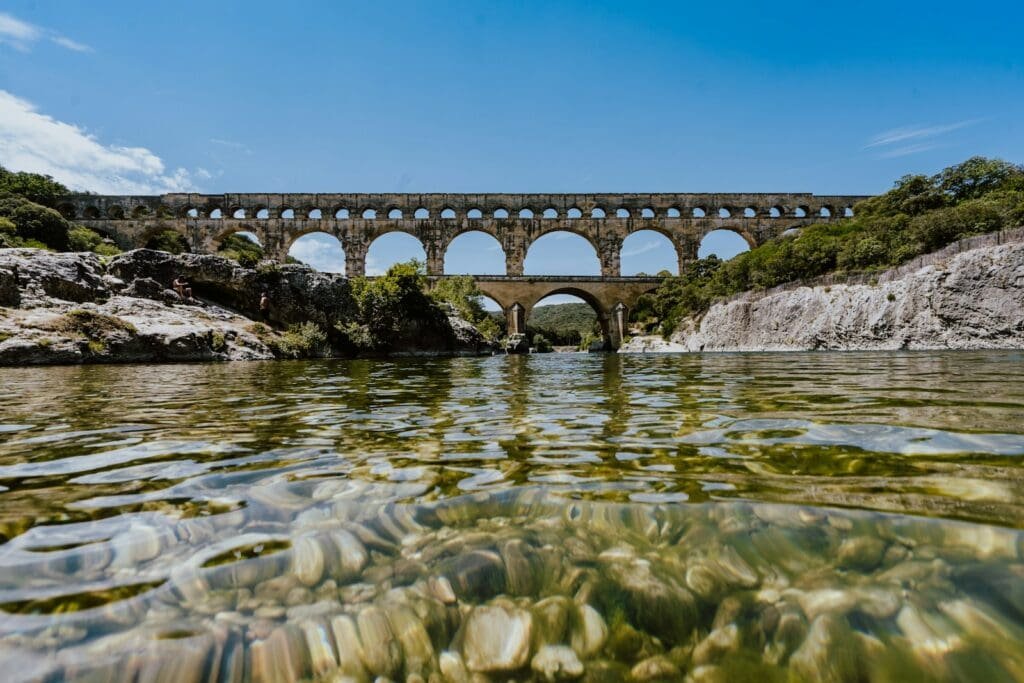Welcome to the Wonderful World of Arches
Keystones and arches are fascinating parts of our architectural history, dating back to ancient civilizations.
In this blog post, we’ll explore the captivating aspects of keystones – from their history, anatomy, function, and even their place in modern architecture.
Did you know the strength and integrity of an arch rely on one special piece, the keystone?
The keystone is the last piece placed during the construction of an arch and it locks all the other stones or bricks into position. And while its size and position may differ from the other stones or bricks (known as voussoirs), they all work together for the stability of the arch.
So, buckle up! This architectural experience takes us from Rome’s grand arches all the way to modern marvels like Antoni Gaudí’s Sagrada Familia and New York’s iconic Brooklyn Bridge.
Let’s get started!
Table of Contents
Understanding the Keystone in an Arch

The Keystone Explained
The keystone is the central, topmost stone or brick in an arch and is key for the stability of the structure. It is typically wedge-shaped (like a trapezoid) and is placed last during construction to lock all the other stones or bricks into position.
Role and Importance of the Keystone
Structural Support
- Distributes Weight Evenly: The keystone helps in dispersing the weight of the structure evenly across all the stones in the arch.
- Maintains Integrity: By holding the arch together, the keystone ensures the integrity and durability of the structure.
Central Position
- Locks Stones Together: Positioned at the apex of the arch, the keystone locks the other stones into place.
- Final Piece: It’s the last piece set during the construction process to secure the arch.
Visual Identification
Keystones are easily identifiable due to their unique shape and central position at the top of an arch.
Examples in Architecture
| Example | Location |
|---|---|
| Arc de Triomphe | Paris, France |
| Old Roman Bridges | Various locations |
Source: Encyclopedia Britannica for more details on architectural concepts.
Further Insights into the Keystone’s Role

Key Elements in the Arch Construction
As the last piece that locks all the other stones or bricks into position, the keystone’s role within arch construction is pivotal. However, each piece within an arch, also known as a voussoir, is equally significant. Architecture depends on combined strength and every voussoir transfers load to its neighbors in a self-supporting arrangement.
Keystone vs Voussoir
Differences
- Size: Typically, the keystone is larger than the voussoirs to ensure it adequately disperses the weight across the arch.
- Position: While a voussoir can be any brick or stone in the arch, the keystone holds the central position at the apex.
Similarities
- Shape: Both keystones and voussoirs have a trapezoidal shape to suit the curvature of the arch.
- Pressure Distribution: Both contribute to the even distribution of pressure across the arch, ensuring its stability.
The Process of Fixing the Keystone
The installation of the keystone is a precise and delicate process. The arch must be fully assembled with all the voussoirs in place, leaving a small space at the apex of the arch. This gap is filled when the keystone is carefully lowered and adjusted until it is securely wedged in place.
Keystone in Modern Architecture
Modern architecture continues to use the keystone concept, although real load-bearing arches are less common due to technological advancements. In many cases, the keystone is now a visual element, giving aesthetic pleasure without serving a structural purpose.
| Modern Keystone Examples | Location |
|---|---|
| Antoni Gaudí’s Sagrada Familia | Barcelona, Spain |
| Brooklyn Bridge | New York, USA |
For more information about the keystone’s role in modern architecture, visit the Architectural Digest.
How Keystones Function Within an Arched Bridge

Historical Context
Keystones have a long history in architecture, dating back to ancient civilizations like the Romans and Greeks who first utilized them in bridge construction. Bridges from these periods often showcased the ingenuity of using arch designs to span distances and bear heavy loads.
Engineering Principles at Work
The science behind keystones and arched bridges involves several engineering principles:
Compression Forces
- Arches are excellent at handling compression forces, with stones or bricks pressing against one another.
- The keystone is central to managing these forces, ensuring they are distributed outward along the curve of the arch to the end supports, known as abutments.
Abutments
- Strong abutments are necessary to resist the horizontal thrust exerted by the arch’s weight and load.
- Properly designed abutments ensure the structure remains stable over time.
Material Choices in Arched Bridges
Different materials can be used for constructing arches, affecting the bridge’s durability and load-bearing capacities.
Stone and Brick
- Traditional materials known for their strength and longevity.
- Each material must be meticulously cut to fit snugly together.
Concrete
- Modern bridges may use concrete due to its robustness and versatility.
- Reinforced concrete can handle both compression and tension forces better.
Famous Arched Bridges Featuring Prominent Keystones
Several well-known bridges highlight the effective use of keystones:
| Bridge | Location |
|---|---|
| Pont du Gard | France |
| Aqueduct of Segovia | Spain |
Environmental and Structural Considerations
Weather Effects
- Freeze-thaw cycles can cause expansion and contraction in the materials, leading to structural fatigue over time.
- Proper drainage systems are essential to prevent water accumulation and subsequent damage.
Seismic Activity
- In seismic zones, arches must be constructed to withstand earth movements.
- Modern techniques may include flexible joints or base isolation systems to absorb shocks.
For additional reading on the impact of environmental factors on arched bridges, check out this detailed article on Engineering.com.
Concluding the Keystone’s Significance
Possessing a historical significance that traces back to the Romans and Greeks, keystones have evolved symbolically and practically, now often serving aesthetic purposes in modern architecture.
Understanding the keystone and its companions, the voussoirs, one understands the concepts of equal load distribution and structural integrity in architecture. The article also touched on how the choice of materials and environmental factors can impact the lifespan and stability of arch structures.
Accordingly, the keystone remains a powerful symbol of strength, lasting sophistication, and ingenious design in architecture, continuing to influence modern construction even in today’s highly technologized society.
Frequently Asked Questions – FAQs
What is a keystone?
A keystone is the central, topmost stone or brick in an arch. It is typically wedge-shaped and key for the stability of the structure, as it locks all the other stones or bricks into position.
What role does the keystone play?
The keystone helps distribute the weight of the structure evenly across the arch. It also ensures the structure’s integrity and durability by holding all other stones together.
What is a voussoir?
A voussoir is any brick or stone within an arch. Every voussoir, including the keystone, equally contributes to the even distribution of pressure across the arch, ensuring its stability.
Why are drainage systems important in arch construction?
In arch construction, proper drainage systems help prevent water accumulation, which can lead to structural damage, especially during freeze-thaw cycles.
What are some examples of keystones in modern architecture?
In modern architecture, keystones are often used for aesthetic purposes even if the structures are not load-bearing. Examples include the Antoni Gaudí’s Sagrada Familia in Barcelona, Spain, and the Brooklyn Bridge in New York, USA.






